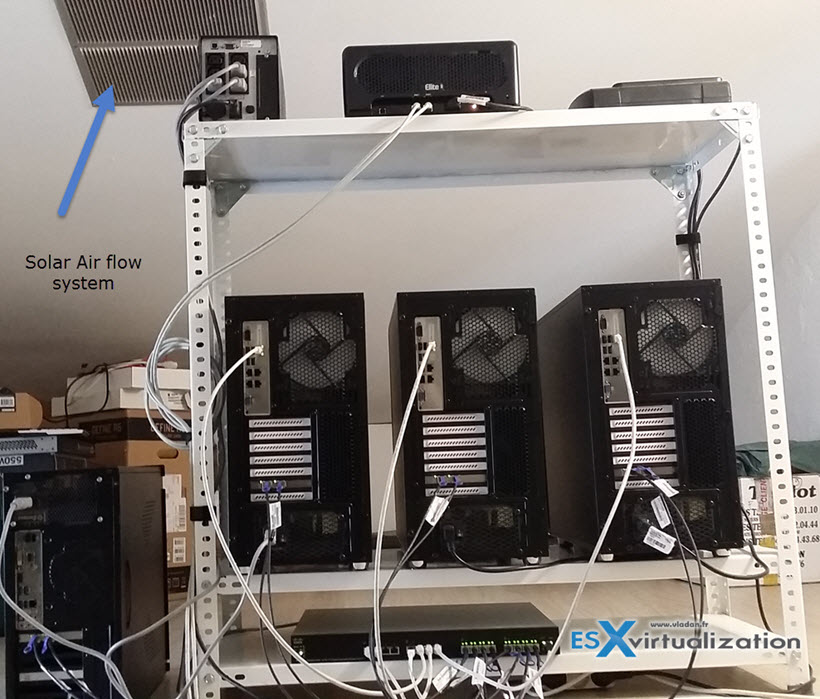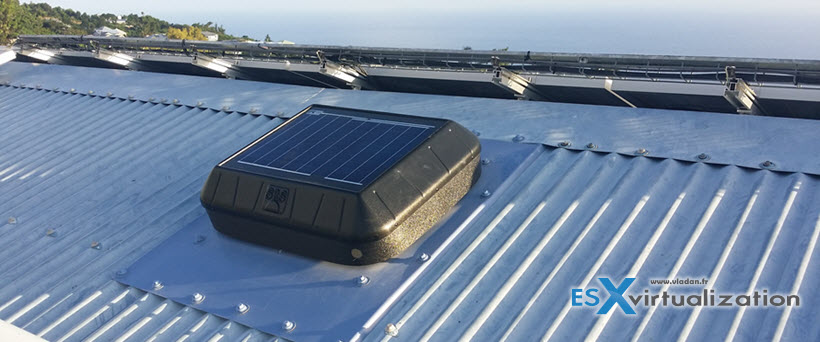As you might already noticed, ESX Virtualization lab is located at Reunion Island – a tropical island with not only beautiful beach resorts, amazing trekking possibilities or a very active volcano, but also with local IT shops, local industry or institutions which need that their IT just works. And that's our role – consultants, IT engineers and technicians. To make sure that things works, all the time, 7/7. Today's post will show you the insight of the new lab room which is literary located under the roof – at the mezzanine where there is only about 1.65m at the very highest point.
The challenge was however not the small height of the room, but rather the heat which especially during the Arctic summer, is quite important. A decision was made however rather than invest in just another air-conditioning system which consumes energy, into a solar heat extractor. Those devices are fairly simple, but robust and most importantly – autonomous on energy. They need no energy to function. The only electro-motor present which is inside has the ability to extract some huge volume of air (up to 2124 M2 per hour!), depending of the external lighting conditions. More sun there is, faster the motor spins. As easy as that. From the costs perspective one must count roughly $1300 all together.
Here is the look from the Inside. The whole lab “sits” on a mounted garage rack bought at the local hardware store, where at the bottom there is a 10Gb Switch and on the shelf there are 3 hosts. (Four actually as the fourth host is a Whitebox – former Haswell ESXi host). I'm running vSphere 6.0, but the storage configuration process isn't finished yet as I'm using one partner's hardware (Enteprise class SATA drives – OCZ's SABER 1000) during test period. The plan is to run either VSAN 6.0 (All-Flash) or Atlantis USX.

Each of the 3 hosts has only the two 10 GbE ports plugged in + the iPMI port used by Supermicro's motherboards.
Energy Efficient ESXi Home Lab:
- Efficient Home Server – Start with an Efficient Power Supply
- ESXi Home lab – Get a quality and comfortable case
- Supermicro Single CPU Board for ESXi Homelab – X10SRH-CLN4F
- Supermicro Single CPU Board for ESXi Homelab – X10SRH-CLN4F – Part 2
- Supermicro Single CPU Board for ESXi Home lab – Upgrading LSI 3008 HBA on the X10SRH-CLN4F – Part 3
- Building Energy Efficient ESXi Home Lab – parts list
- Homelab – Airflow Solar System – [ This Post ]
Let's get back to the The Solar extracting system. The electric motor is only small 20 W one, but the extracting quantity of air is quite phenomenal. We have now entered almost into a winter time so the heat on the mezzanine is lower, but during a sunny day (there is over 300 per year here) the system works as expected.

The system do not operate at night as during the night the heat is much lower and the hosts generate really not much heat at all, due to the low power Xeons and SSDs, and efficient powersupplies. But it's possible to get the same system hooked with small battery which recharges during the day and spins the electro-motor during the night. I did not wanted this solution as I did not jugged that necessary.
Note on the other side of the roof (facing the sea) there are solar panels, which generates electricity for roughly 3 houses (as I've been told). The house's solar system is plugged right into the grid, so I do not consume any of it, but a yearly rent is paid back from Electricité de France (EDF) instead.

The company which did the installation of the Solar extracting system is a local company here at Reunion, which also installs other interesting systems, like systems where you can bring light to rooms where is not enough light normally. You know, through the roof. If France we call it “puits de lumière”. (Solar Tube ???). Check their website if you want more info.
Well I guess that this is it, concerning the lab series. Perhaps one of my future posts will get more insight on what's currently installed. As concerning the network I took the plunge, broke the bank and went for a 10GbE switch from Cisco – SG500XG-8F8T. The same switch that Erik Bussink uses in his lab.

Concerning the 10GbE network cards I opted for low power, low consumption Intel Ethernet Controller X710-da2 cards with SFP+ connectors, So each host has two 10Gb ports. I haven't done much tests on the speed of the network, just noticed the speed when vMotion a VM. Now for example, a 8Gb RAM VM running 2012 R2 Winodws server takes 4s to vMotion from one host to another. The overall consumption is roughly about 400W, as the Cisco switch and the Drobo are for something….
Wrap up:
While there are many offers to built a nested lab (Autolab, Ravello, VMware Labs….) the lab hardware was always for me not only to learn VMware technology, learn towards VCP or VCAP exams, but also get the hands on – physically. To play with it. When I was younger, I use to do RC gliders and motor planes. I always liked to work with my hands, touch stuff, play, create. I'm by nature curious. Now even if I grew older, the fact to play with stuff is important part of my life. I guess I'm not the only one -:). Important was to me to get relatively low power consumption, break the 64Gb RAM barrier, and 10Gb network.
We can hardly call it a home lab as for most homelabbers it's pretty overkill, but for me the reason to have an enterprise lab is also to be able to install and test products, because part of my activities, through the blog as a commercial entity, is to provide certain services, which are paid services like reviews and (or) product tests.
When I first started to blog, back in 2008, I first thought that I'll bookmark few virtualization how-to's and news to my own space. WordPress as a blogging platform was just a fact that WP was easy to put in place, had lot's of free plugins and themes and there was tons of tutorials. The ESXi homelab is no longer a personal home lab, the blog is no longer a personal blog (runs on dedicated hosts with over 460 000 page views last month), but the person who runs and both is still the same IT guy… -:)

Awesome HomeDC you have there.
Looking very good.
Thanks Erik. Your lab inspired me quite a lot… -:)
Awesome homeDC.
I have ordered a pair of x540T2 dual converged network adapters. However I haven’t opened them yet. So now i’m thinking of getting the x710DA2. What version of it you are using as there are apparently 3 versions.
Any suggestion would be highly appreciated.
Cheers!
Mo’
I’m not sure about what you’re asking for. There is a version with 4 ports (the DA4) and also the DA2 which I got…. http://www.colfaxdirect.com/store/pc/viewPrd.asp?idproduct=2227&idcategory=0
Thanks for the speedy reply.
I got the answer as I wanted to know which one your ordered.
Cheers!
Mo’
Hi Vladan,
Would appreciate if you could share on how you were able to connect the fractal design R4 casing fans with the motherboard.
I couldn’t seem to find the connectors on the motherboard !
Did you order a special connector for the casing fan so that they can be connected to the MOB ?
Cheers!
Mo’
The front fan’s cable was quite hidden to grab, but the connector’s on the motherboard are quite visible -:)…
Never mind as i was able to locate the fan connectors. One thing i’m still struggling is that power LED + and power LED – connectors.
Have been referencing the MOB manual but still could not put a finger on it yet.
Finally I was able to locate all the cables. I will be powering these two hosts over the weekend as the 10 gig switch is all set 🙂
Cheers!
Mo